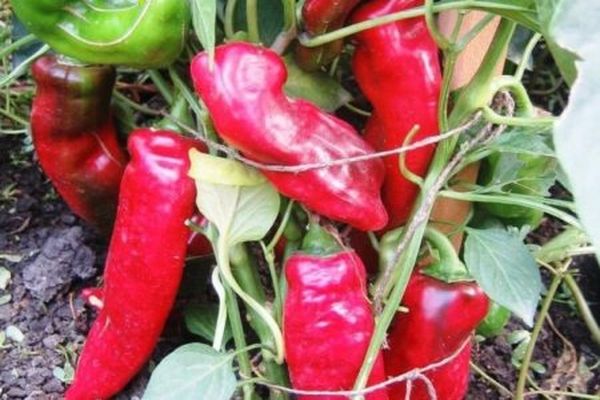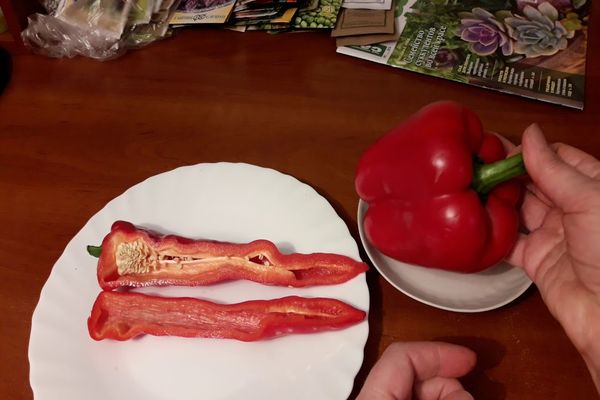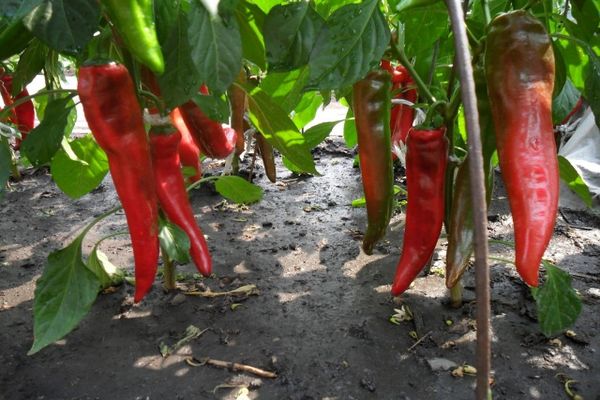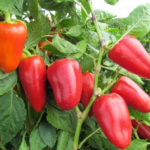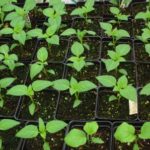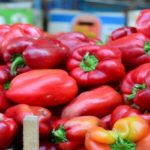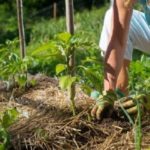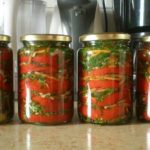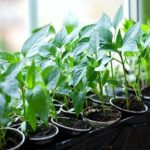Ramiro pepper is the property of Italian breeders. Despite the highly elongated shape, the taste of the fruits is much sweeter than that of the Bulgarian species.
Description
High-yielding mid-season variety. The fruits ripen 130 days after emergence. The height of the bush is 90 cm. The shape of the pepper resembles a large chili. The skin is thin. The length of the fruit is 25 cm with a wall thickness of 0.5 cm. As for color, there are several varieties: red, yellow, green. The average weight of a vegetable is 90–150 g. The taste of pepper is sweet. One plant bears 10–12 fruits. Pepper can be stored for 3 months.
The variety is intended for growing indoors, but in good weather conditions it can also grow in the garden.
As you can see, the characteristics of the Ramiro variety are very impressive. However, we should not forget that all these advantages can be crossed out by improper care. What rules should you follow when growing vegetables?
Technology of growing seedlings
Pepper is a vegetable crop that is grown in seedlings in most regions. You can sow seeds of the Ramiro variety in a garden bed only in the southern part of the country. The crop is grown using the following technology:
- A mixture of rotted manure, garden soil, and sand (2:1:1) is used as a substrate. To destroy accumulated pathogenic bacteria, the soil is calcined in the oven before planting. Please note that the temperature during such treatment should not be higher than +60 ⁰С, otherwise the land will become unsuitable for growing plants.
- The naturally long germination of peppers is improved by soaking the planting material in a growth stimulant. After 4–5 hours of “bathing,” the solution is drained, and the seeds are washed with water, dried or sown immediately. Planting depth - 2 cm.
- The seedling container or individual containers are covered with film and placed in a dark place where the temperature is above +20 ⁰C. After the sprouts appear, the covering material is removed and the seedlings are transferred to the windowsill.
It is known that cold water is not suitable for watering many crops, including pepper. To moisten the substrate and air, it is best to use settled water at room temperature.
Since excessive moisture is the main cause of disease and death of young plants, watering should be carried out only after the soil has dried, and the room itself should be regularly ventilated.
14 days before transplanting to a permanent place, the pepper is hardened. Take the containers out onto the balcony and gradually increase the time spent in such conditions from half an hour to the whole day. Seedlings are considered ready for planting at the age of 60 days. According to calendar dates, planting takes place in the third ten days of May or early June.
Features of cultivation
When choosing a bed for Ramiro peppers, you need to take into account not only the light, but also its predecessors. So, it is best to plant the crop after pumpkin, cucumbers, zucchini, and cabbage. For disinfection purposes, a week before the expected planting date, the soil is generously sprayed with a solution of copper sulfate. When digging, add ammonium nitrate - 30 g per 1 square meter. m.
To protect the peppers from flooding and strong drafts, make a 30 cm mound and plant indeterminate varieties of tomatoes in the rows. The seedlings are planted in holes 15 cm deep and then watered with slightly warm water. In the southern regions, where the soil dries out too quickly, the crop is mulched with peat.
Watering
The frequency of moisture directly depends on the stage of development of the pepper. So, during the growth period and during fruit filling, watering is done once a week, and when the ovaries are forming - 2 times. Water consumption per 1 sq. m. of plantings - 6 l. As with growing seedlings, water for irrigation should be warm. After the next application of water or rain, the soil is carefully loosened.
Top dressing
Ramiro peppers are very sensitive to fertilizers. Therefore, in order for the description of the variety to exactly match the grown plants, root and foliar fertilizers are used together.
The first time young plants are pampered with fertilizers is 2 weeks after planting. Pepper is fed with a solution of cow manure (1:15) or chicken manure (1:10).
To prevent the ovaries from falling off, peppers are treated with a mixture of boric acid prepared at the rate of 2 g of the substance per liter of water. During the flowering period, bushes growing in the garden are sprayed with sweet water, which attracts the attention of bees. Foliar feeding is carried out in the morning and evening hours.
The second root dressing is applied to faded plants. To prepare the nutrient mixture, 20 g of potassium nitrate and superphosphate are mixed alternately in a bucket of water.
Thanks to these chemical elements, the pepper's root system is strengthened and the taste of the fruit is improved. The same fertilizing is applied after harvesting the first crop, as it increases the duration of fruiting.
Formation
In order to prevent diseases and pests, Ramiro peppers are molded twice. The first time the inflorescence is cut off is after the plant forms the first branch. As a rule, the height of the plant by this time reaches 20 cm.
The second time the procedure is carried out after the formation of the 10th sheet. Only 2-3 strong shoots are left on the bush, and all the rest are removed. A properly formed bush should have no more than 20–25 ovaries.
Have you grown this sweet pepper variety? Was the description confirmed?


